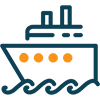
|
|||||||||||||||||||||||||||||||

Supply chain industry deals with multiple stakeholders within a single transaction. Hence, several moving parts are involved that need to be managed and optimized for efficiency and cost. It’s a critical success factor across many industries, as they provide the last mile connectivity for goods and services. Today, supply chain businesses have to cope up with regulatory frameworks, terrorism, bad weather, and economic upheaval. Ability to predict and manage these factors efficiently is one of the primary objectives of the supply chain.
Analytics, here, plays a vital role in helping supply chain practitioners gain real-time insights, foresight, and analysis. Predictive intelligence and prescriptive analytics tools have a higher utility in this space, as real business cases in the supply chain can be applied for a better ROI and enhanced customer experience.

Companies use the rail network to transport their goods to the intended destination according to the logistics chain. Rail freight operations look after this mode even though shipment by rail might not always be as flexible as by road.

These consist of the firms that provide regular public service of air transport over one or more routes within and outside a specified region. They are issued a license by the government body for aviation to carry out these operations without any hurdle.

Transportation on the road could be of goods or even people by motorized and non-motorized carriages between two destinations.

Luxurious passenger ships used on a regular line are ocean liners. Although they may also carry cargo or mail or sometimes be used for other purposes such as hospital cruises and commercial cruises.

The warehouse operators deal with the products and goods that come into a warehouse. Apart from this, they also check for damaged or missing goods, move the stock around, and keep the paperwork up to date.

A third-party logistics handles the shipment, i.e., handling, receiving, storing, and delivery of the goods. A fourth party logistics manages the whole supply chain, i.e., from the supply to the legal work and managerial decisions.

ICD is a make-shift location that acts as a port in the absence thereof. Terminal operators are the companies that contract with the port authorities to move the cargo through a port. They could be privately run or state-owned.

As opposed to moving the freight themselves, freight forwarders act as the intermediary between the shippers and various other transportation services.
Everything in the supply chain starts with an order, which can be of two types - inbound and outbound. Inbound requests deal with receiving goods into the chain and outbound deals with distributing products to the end consumers. Orders can also pertain to movement of goods within the supply chain to optimize inventory and meet business demands occurring from time-to-time. Stocks transfer or warehouse movements to and from central distribution center and regional distribution center movement are the examples. Some of the significant KPIs measured as part of this function are:
There are two types of warehouses - dry warehouses and cold stores. The goods are stored in ambient temperature in dry warehouses, whereas the perishable goods need to be maintained within a particular temperature range to ensure product freshness. The latter is called the cold store. Another classification applicable could be based on operations, such as manual, semi-automatic, and fully automatic. A warehouse is a crucial element in any supply chain. It is not only a place for storage of goods, but also a place where much value adding activities take place such as knitting, assembly, and repairs. These activities depend on the type of industry and goods moving in the chain. Optimization in a warehouse involves space, assets, and resources.
Analytics plays a vital role in helping warehouse operators understand the undercurrent and take necessary corrective actions in real-time to ensure maximum throughput in an optimized cost structure. Also, S&OP—supply and operational planning—depends a lot on the inventory and warehouse management. This process allows businesses to plan strategies around the organizational resources to serve their customers while staying profitable.
Some of the KPI that you can analyze under this function are:
Transportation provides the last mile link in the supply chain. It can be broadly classified as long-haul and secondary distribution, within which, dry and temperature-controlled storages fall. Long-haul distribution deals with the movement of goods from one city to the other, involving large trucks moving up to full capacity of loads of products either from a single customer or via modes of consolidation. Other distribution deals with milk runs within a particular city for distribution of goods, which is also the true last mile link within the transportation space. This function needs precise yield management like yield per trip or km. Transportation is a high CapEx and OpEx function and hence needs to be managed effectively to ensure maximum ROI is achieved through each asset. Some of the KPIs for this function include:
Logistics management deals with the physical flows of goods through the supply chain, both at the inbound and outbound side. This function deals with multiple vendors who are required for the execution of the transaction, for example, liners, airlines, freight forwarders, NVOCC, CHA, etc., who are necessary for moving goods from origin to destination across international borders. A standard metric used in this function is the total landing cost metric, which determines the best route for moving goods between two points considering all cost incurred in the process of delivery. Yield per ton is also a common yield management KPI. Network and route optimizations are also standard methods used within this function for increasing efficiency and effectiveness. Some of the other KPI’s covered in this function include:
Customer service is one of the key links in ensuring that the on-boarded customers are retained for longer periods so as to obtain repeat orders. Customer service divisions cater to key services such as Shipment Documentation, Consignment status tracking, Priority shipment assistance, etc. Effectiveness of the customer service division can be tracked by monitoring key operational metrics such as
We are a team of cross function and cross industry experts who build, test, and deploy analytical solutions to assist organisations in increasing process efficiency and reducing business risks.